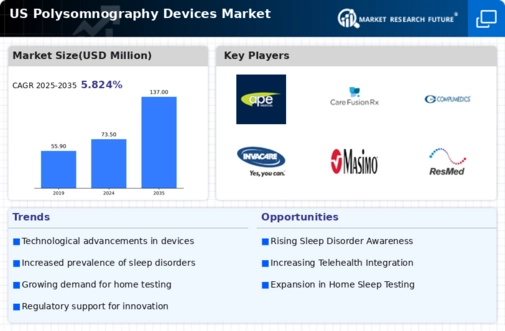The US Polysomnography Devices Market is a highly specialized segment within the medical technology industry that focuses on sleep disorder diagnostics and monitoring. This market has gained traction due to the rising prevalence of sleep apnea and other related disorders, driving demand for advanced diagnostic tools and devices. Competitive insights reveal a landscape characterized by innovation, strategic partnerships, and an escalating emphasis on enhancing the quality of sleep diagnostics.
Manufacturers are increasingly focusing on developing user-friendly and technologically advanced devices that incorporate features such as cloud connectivity, mobile applications, and real-time monitoring to provide efficient and accurate assessments for clinicians and patients alike. The market is also witnessing accelerated growth driven by regulatory approvals, heightened awareness among healthcare providers, and a growing demographic of aging patients who are more susceptible to sleep-related conditions.
Ape Medical has established a strong foothold in the US Polysomnography Devices Market through its commitment to innovation and quality. The company specializes in providing state-of-the-art sleep diagnostic equipment, which is recognized for its reliability and ease of use. Ape Medical has developed a portfolio of products that cater to various sleep disorders, emphasizing accurate data capture and user comfort. Its strengths lie in its research and development efforts, which enable the company to stay ahead of industry trends and regulatory changes.
The company enjoys a robust market presence bolstered by strategic collaborations with healthcare facilities and sleep centers across the US, positioning itself as a trusted partner in sleep diagnostics.
CareFusion, known for its comprehensive range of medical devices and technology, has significantly influenced the US Polysomnography Devices Market. The company offers an array of polysomnography devices designed to enhance patient monitoring and diagnosis. CareFusion's products focus on providing precise measurements and facilitating better patient outcomes, which is critical in the sleep disorder diagnostics landscape. The company maintains a solid market presence through various strategic initiatives, including mergers and acquisitions that have expanded its technology portfolio and market reach. CareFusion’s ongoing commitment to research and development allows it to introduce cutting-edge technologies aimed at improving diagnostic accuracy and patient comfort.
Additionally, its established relationships with healthcare providers reinforce its status as a key player in the US polysomnography market, offering innovative solutions that meet the growing demands of clinical sleep diagnostics.



















